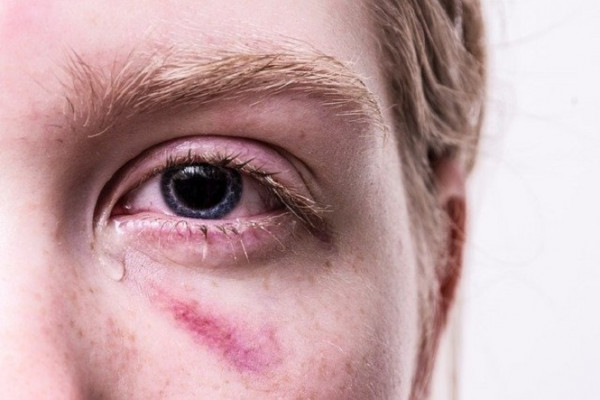|
Seek medical care immediately if you: |
|
Low or no data? Visit zero.govt.nz, scroll down the page then click on our logo to return to our site and browse for free.
Eye injuries
Also known as eye trauma
Key points about eye injuries
- Eye injuries can be caused by a direct blow, something getting into your eye, flash burns or chemical burns.
- Symptoms of eye injuries depend on the causes.
- Minor eye injuries can be treated at home – see self-care section below.
- More serious eye injuries need medical attention – see first aid for eye injuries and when to seek urgent medical attention below.
- Most eye injuries are preventable. Wear safety glasses or protective goggles if there is any risk to your eyes.

Common causes of eye injury include the following:
- Chemical burns – exposure to strong chemicals, such as oven cleaner or bleach.
- Corneal abrasion – scratch to the front of your eye.
- Foreign body – an object that shouldn't be in your eye, such as a piece of glass, dust, seed, wood chips or a sharp object. A foreign body can cause injury to your eye by scratching the cornea or penetrating (going into) the eye.
- A direct blow to your eye – a strike to your eye by hard or sharp objects, such as a baseball, fist or metal. This can injure the contents of your eyeball or surrounding structures such as the eyelid or the bones around your eye (orbit).
- Flash burns – damage to the cornea caused by exposure to bright ultraviolet light from sources such as a welding torch, direct sunlight, a sunlamp in a tanning salon or a reflection of the sun off snow.

Image credit: Pixabay
Symptoms of eye injuries depend on the causes.
- Symptoms of a chemical eye injury include a sudden painful watery red eye after you've been exposed to chemicals. There may be a delay in symptoms if you've been exposed to a noxious (toxic) gas.
- Symptoms of corneal abrasion and corneal foreign body include a severely painful, watery and red eye with increased light sensitivity. Your vision may be hazy if the abrasion is central.
- The symptoms of blunt trauma can range from the appearance of a sunken eye or a protruding eye, double vision, pain, blurred vision, bruising and red eye.
- If you have sudden loss of vision when you've been doing something involving a small object moving quickly eg, hammering metal on metal, you may have had your eye pierced.
- Symptoms that you have broken the bones around your eye include double vision, with or without pain, but still being able to move your eye.
You can seek eye care from your GP, emergency clinic, optometrist or an ophthalmologist. Most eye injuries are covered by ACC.
Your eye care provider will ask you specific questions related to your injury, including how the injury happened and what object(s) was involved.
Diagnosis requires an eye examination, which may include:
- measuring your vision
- anaesthetic drops – numbing drops so your eye can be examined
- inspection with specialised instruments – ophthalmoscope and slit lamp exam
- putting orange dye in your eyes, which reveals damage to the front of your eye – the dye is harmless and washes out with your tears
- x-rays or CT scans.
Treatment of eye injuries depends on the nature and extent of injury. Follow the specific instructions of your eye care provider, as different eye injuries require different treatment. You may need to be referred to an ophthalmologist (a doctor with specialist training in assessing and treating eye conditions) depending on how severe the injury is.
The treatment of eye conditions includes the following:
- Dilating drops to relax your eye muscles and, hence, reduce pain. Your pupils (the black part of the eye) will look bigger than normal for a few days.
- Eye pad/dressing – your eyes may be padded to allow healing. Don't drive with an eye patch on.
- Eye drops/ointment – note how often to use the prescribed eye drops or ointment.
- Follow-up – you may be reviewed in 24–48 hours to make sure that your eyes are healing as some conditions such as infection may be delayed in onset.
- Pain-relieving medication such as paracetamol, ibuprofen or codeine.
- Sunglasses if your eyes are sensitive to light.
- Artificial tears or lubricants to help any discomfort in your eyes.
Direct blow to your eye
A blow to your eye can damage the eye and its nearby structures. Place an ice compress on your eye immediately for 15 minutes to reduce pain and swelling. This could be a bag of frozen peas or commercially available ice packs.
Seek medical attention if you have symptoms of reduced vision (as this may indicate a bleed within the eye), pain on eye movements or double vision (as this may suggest a fracture of the bones around the eye), if the eye appears sunken (suggestive of fracture) or more prominent (suggestive of blood or air behind eye) or if there is significant swelling of the eye.
Chemical burn to your eye
If your eye comes into contact with any strong chemicals, such as oven cleaner and bleach, follow these steps immediately:
- Flush your eye with running clean water (not hot) for at least 15 minutes.
- Hold your eye wide open with your fingers and make sure all surfaces of your eyeball are flushed.
- Then go to the nearest emergency department immediately.
- Bring the chemical container with you if possible or take a picture of its ingredients.
Treatment of eye injuries depends on the cause. Follow the specific instructions of your doctor, as different eye injuries require different treatment. You may need to be referred to an ophthalmologist (an eye specialist) depending on the severity of the injury.
Something in your eye
If you suspect something has flown or penetrated your eye, protect the eye with a pair of glasses or sunglasses and ask someone to take you to the nearest emergency department immediately. The object may need removal surgically by an ophthalmologist.
- Do not try to remove an object that has pierced or penetrated your eye yourself and do not rub your eyes.
- Do not have anything to eat or drink until you are assessed by a doctor, as you may require urgent surgery.
- Check your tetanus status, and get a booster injection if needed.
Flash burn or light radiation to your eye
If you are exposed to bright light or high ultraviolet light and experience symptoms of discomfort, reduced vision, red eye and light sensitivity, you may be experiencing a flash burn to your eye (also known as arc eye). See your eye care provider for assessment. You may also be given a mild steroid-based anti-inflammatory drop to manage your condition.
In general, follow these steps to remove something small or minor from your eye such as an eyelash, a piece of dust or an insect:
- Do not rub your eyes.
- Wash your hands before touching your eye.
- Look in a mirror to see the object in your eye.
- Blink to allow your tears to wash the object out of your eye.
- Hold your eye wide open using your fingers and roll your eyeball.
- Use a wet cotton swab or a clean cloth to remove floating particles or eyelash.
- Rinse your eye with plain water using an eye cup or a small glass to flush the object out.
- Do not remove any object that has pierced, penetrated or is stuck in your eye.
Most eye injuries are preventable.
- Wear safety glasses whenever there is any risk of danger to your eyes, such as when drilling, sawing, handling strong chemicals and gardening.
- Wear protective goggles if your workplace has any risk of danger to your eyes, such as if you handle cement, plaster dust or glass.
- Wear specialised ultraviolet protection when there is a lot of light radiation, such as when welding or skiing.
- Wash your hands regularly before touching your eyes.
- Wear eye guards when playing sports such as squash or baseball.
General suggestions for using eye drops and ointments include to:
- wash your hands before touching your eyes
- rest your finger on your cheek and pull down the lower eyelid
- tilt your head back and drop the liquid into your lower eyelid
- for ointment, smear a small amount (1mm strip) along the inside of your lower eyelid
- make sure that the nozzle doesn’t touch your eye
- keep all drops and ointment in the fridge and out of reach of children.
If you are prescribed eye drops or eye ointments, you can also ask your doctor or pharmacist about using eye drops or eye ointments correctly.
- In an emergency, call 111
- Your doctor
- Emergency department of your nearest hospital
- Ophthalmologist
- Optometrist
Eye injuries(external link) Health New Zealand | Te Whatu Ora
Eye injuries(external link)(external link) St John, NZ
Eye injuries(external link)(external link) NHS, UK
References
- Trauma in eyes(external link)(external link) Auckland Regional HealthPathways, NZ, 2020
- Foreign body in eye(external link)(external link) Auckland Regional HealthPathways, NZ, 2020
- The Wills Eye Manual: Office and emergency room diagnosis and treatment of eye disease (7th ed.) Lippincott Williams & Wilkins, 2016
Penetrating eye injuries (subscription required)(external link) GP Eyes, NZ
Eye emergency manual – common emergencies(external link) New South Wales Department of Health, Australia
The Wills Eye Manual: Office and emergency room diagnosis and treatment of eye disease (7th ed.) Lippincott Williams & Wilkins, 2016
Credits: Healthify editorial team. Healthify is brought to you by Health Navigator Charitable Trust.
Reviewed by: Dr Divya Perumal, ophthalmologist, Auckland
Last reviewed:
Page last updated:





